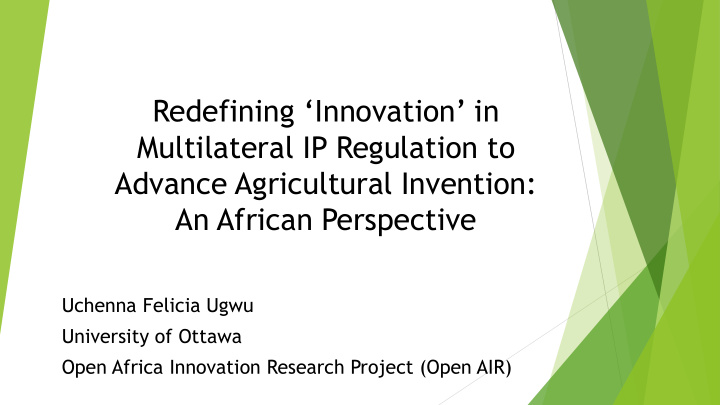



Redefining ‘Innovation’ in Multilateral IP Regulation to Advance Agricultural Invention: An African Perspective Uchenna Felicia Ugwu University of Ottawa Open Africa Innovation Research Project (Open AIR)
Relationship between IP and Agricultural Innovation “ An innovation is the implementation of a new or significantly improved product (good or service), or process, a new marketing method, or a new organizational method in business practices, workplace organization or external relations ” (OECD) Intellectual property rights (IPRs) refers to the authority granted by law to inventors to control and benefit from the creations of their minds. IP protection grants power to own an idea in a similar manner to ownership of physical property. IP regulations dictate how innovative knowledge may be accessed, used, and transferred across borders IP may prevent access to seeds, improved crop varieties and genetic resources essential to agriculture ‘One size does not fit all’ in using IP to advance varying forms of innovation across sectors and countries
Formal and Informal of Innovation Formal Innovation Informal Innovation Based on Scientific Research & Development Based on Traditional Knowledge and on the job learning Protected through Exclusive Monopolistic Protected by Customary law and Practices IPR: Patents & PBR including: Open Access, Inclusive Community Resource Rights Individually developed via quantum leaps, Collaboratively developed through time specific incremental knowledge Motive: Profit Maximization Motive: Non monetary, self gratification Driven mostly by private companies Driven by individuals and public sector institutions like universities Transferred by documentation Undocumented, Passed on orally Promoted by big corporations and developed Promoted by smallholder agriculture and countries developing countries Top-bottom innovation Grassroots: bottom-top innovation Only recognizes innovation by producers; Recognizes open, collaborative and user Uniform and stable invention; More biodiverse
Characteristics of Agricultural Innovation in Africa Based on traditional knowledge, local processes, subsistence farmers Held collectively by communities or groups rather than individuals Allows open access to knowledge & free exchange of seeds and plant varieties Closely connected with lands and culture Highly biodiverse, with greater varieties Occurs in informal sector and some public institutions Developed mostly by smallholder farmers & focused on local seeds and crops rather than GMC
Requirements for ‘Innovation’ in IP Regulations (TRIPS & UPOV) TRIPS, Article 27.1: “ patents shall be available for any inventions, whether products or processes, in all fields of technology, provided that they are new , involve an inventive step and are capable of industrial application .” UPOV, PBR, Article 5.1: a variety must be new, distinct, uniform and stable New: if, at the date of application for the PBR, the propagating or harvested material of the variety has not been sold or otherwise disposed of to others Distinct: if it is distinguishable from any other commonly known variety Uniform: if, apart from the variations that occur during propagation, the plant’s characteristics are consistent from plant to plant within the variety Stable: if the plant characteristics are genetically fixed and remain unchanged over time after repeated propagation
Impact of Patents and PVP on Agricultural Innovation in Africa Restriction of Farmers’ Rights, in favor of PBR & Patents Increased dependence on foreign imported technology Seed market dominated by multinational corporations, rather than smallholder farmers Piracy of locally developed crops and biodiversity Threatens local food security and biodiversity Reduced incentive for local innovation; No PIC and ABS Recognition of formal rather than informal sector inventions Non protection of traditional knowledge & herbal medicines Increased harmonization rather than differentiation of IP laws and policies (OAPI, ARIPO TRIPS-Plus)
Africa’s INNOVATION Traditional Agricultural Produce
Expanding the definition of “Innovation” in IPR to include traditional agricultural innovation in Africa Recognize Innovation as a Process, not just a product Recognize Open, Collaborative and User Innovation Recognize Traditional Knowledge as Innovation Recognize Farmers’ Rights (as Innovators and Breeders) Promotion of Sustainable Innovation for Plant Varieties Recognize IPR as a Functionalist Tool for Advancing Public Interests Define Innovation in Relation to Other Multilateral Agreements (CBD, Nagoya Protocol, ITPGRFA & African Model Law) Adopt Alternative Metrics for Measuring Innovation Permit Differential Interpretation of Innovation based on Context (country and sector)
INNOVATION Alternative IP Innovation
Attribution Icons made by Freepik from www.flaticon.com are licensed by CC 3.0 BY
Recommend
More recommend